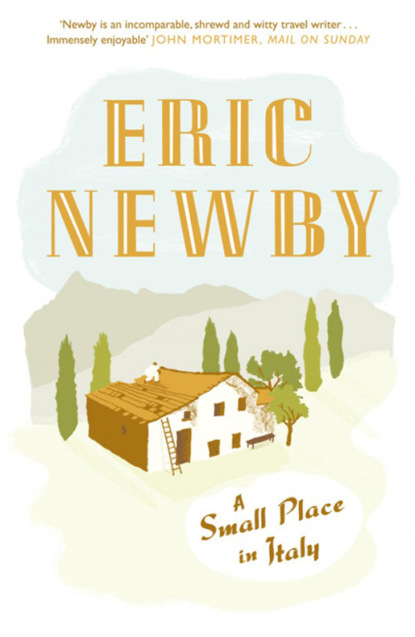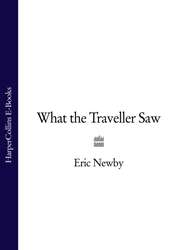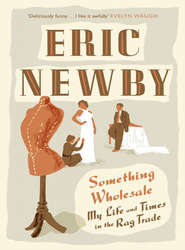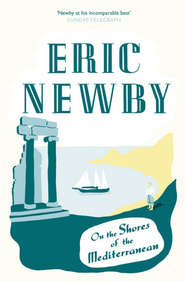По всем вопросам обращайтесь на: info@litportal.ru
(©) 2003-2024.
✖
A Small Place in Italy
Автор
Год написания книги
2018
Настройки чтения
Размер шрифта
Высота строк
Поля
All the years we subsequently lived here we had trouble with what Signor Vescovo described as the eighteenth bend from Caniparola. Wanda made it the twenty-second, I made it the twenty-first and none of the friends who came to stay with us was able to agree how many there were either. It was a waste of time appealing to the local inhabitants, they had never even attempted to count them.
Signora Angiolina was hovering in her vegetable patch outside her house, awaiting our arrival. As she told us, she had just finished feeding her rabbits which lived in a large wooden hutch at the back of the house.
The house looked bigger than it really was as she had rented a large room on the ground floor to a communist social club which was, at the moment, like the cell at the seventeenth bend, more or less moribund, but not completely so, and subsequently it started up with evenings of very un-communist pop which would have made Lenin turn in his grave.
Signora Angiolina’s husband had died a couple of years previously and because of this she was in deep mourning, which meant that she was dressed in black from head to foot: black headscarf, black cardigan, black skirt, reaching below the knee, black woollen stockings – normally she wouldn’t have worn any at all before the cold weather set in – and black felt slippers.
The only item that wasn’t black was her apron which was dark navy with small white spots on it, which helped to cheer her outfit up a bit.
Later she told Wanda that she was fed up with being in mourning – the navy apron was probably a first sign of rebellion against it – and she was looking forward to leaving it off and quite soon she did so, which raised her spirits no end.
Signora Angiolina was in her sixties when we first met her, and was very slim. She had nice, bright-blue eyes and she cried easily. She had greyish-brown hair drawn back tightly from her forehead in a bun, now hidden by her headscarf. And she had a really lovely smile.
It was a tragic face but a beautiful one, a beauty, one felt, that would endure and in fact it did, until the day she died. Even seeing her briefly for the first time it was obvious that at some time in her life something awful had befallen her but we had to wait until we were on more intimate terms with her in order to discover what it was.
Like most contadini she was wary of people such as ourselves who came from cities and were foreigners but, in spite of this, she did bestow on us this lovely smile.
However, when Wanda asked her if she would take us to see the house and unlock the doors for us so that we could see the inside, which was the purpose of our visit, she suddenly looked serious, shrugged her shoulders in a way that was almost imperceptible, and said, ‘ Ma!’
This seemed like bad news. In my experience almost all the Italian contadini I had ever met who used this expression had done so in a negative sense, one that usually boded ill.
When, for instance, while on the run in Italy during the war, I had asked the contadini for whom I was working in exchange for food and a roof over my head, if I had any chance of remaining free when the snow fell in the Apennines, something I had been thinking about for some time, there was no doubt as to what they meant when they said, ‘Ma!’ They meant ‘No!’ And they were right. But Signora Angiolina’s ‘Ma!’ was of a different sort. One she used in the sense of ‘Chissa?’ (‘Who knows?’)
But this was not her only interpretation of ‘Ma!’ If you asked Signora Angiolina, ‘Che sarà successo?’ (‘What can have happened?’), a question that we would be asking all and sundry in this part of rural Italy for the next twenty years or more, one which could cover any sort of calamity – a blow-back in a septic tank, the sudden disappearance of the roof, or the cessation of the water supply – her first reaction would be to say ‘Ma!’, implying that she didn’t know.
What she meant by ‘Ma!’ in this particular instance, as Wanda subsequently explained to me, being more practised in the understanding of such things, was that she was not the actual owner of the keys, and was therefore expressing trepidation at the thought of having to be responsible for opening doors to rooms to which she may not have had access previously, unless someone had died in one of them, in which case she might have entered it for the wake.
Worst of all, for her, was the idea of opening them up for a couple of unknown persons who might quite easily turn out to be robbers. But in spite of all this, the implication was that she would do it. It was all rather confusing.
Her other favourite expression, one which she used when confronted with a fait accompli which had on the whole turned out well, as, for example, if I had cut down, as I subsequently did, one of two trees, and it turned out to be the right one I had felled, not the wrong one, was ‘Hai fatto bene!’ (‘You have done well!’), uttered in resounding tones.
I loved it when Signora Angiolina gave me one of her ‘Hai fatto bene!’ broadsides. It always gave me the feeling that I had just received an accolade from the Queen for saving her corgis from being run over, or that I had just been kissed on both cheeks by General de Gaulle after having been decorated with the Croix de Guerre avec Palmes for doing something frightfully brave and important – ‘Well done, Eric!’
In fact if Signora Angiolina called me anything it was what everyone else called me in this part of the world, that is if they called me anything, which was ‘Hayrick’ without the ‘H’, ‘Eyrick’, or failing that ‘Enrico’.
So now, having delivered her ‘Ma!’, Signora Angiolina went off to get the keys from some hiding place, five of them altogether, all very old, three of them large and very beautiful works of art.
Then, having armed herself with a small reaping hook and giving it a preliminary sharpening on a special sort of sharpening tool embedded in a large log, she set off down the track, leading the way, to the place where Signor Vescovo had written that there was a way to the right off the main track. From this point it then made a very steep, slippery descent to a little bridge which, at that point, spanned a torrent.
‘The track goes down through a chestnut wood,’ he had written, ‘which is why the houses and the place are known as I Castagni.’
The bridge which spanned the torrent was nothing but a couple of cement drain pipes covered with earth. The torrent itself was deep, narrow, bone dry and almost completely hidden from view by the chestnut trees which soared up into the air from the ravine the stream had carved for itself. The bed of the stream was horrible, filled with the refuse that people further up the hill had chucked into it: bits of plastic sheeting, half buried in the bottom of it, empty bleach containers, rusty tins and other assorted muck.
Now, for the first time, we saw the house.
It stood at the far end of a grassy dell, overlooking the terraced fields that covered the hillside one above the other, and it was surrounded by vines and old olive trees that cast a dappled shade as their branches moved in a light breeze from the west.
The house itself faced south. It was sheltered from all the winds that blew between north-east and south-east by the groves of chestnuts that also rendered it invisible from further up the hillside in summer, and did so even now in what was autumn although the leaves were beginning to thin out.
It was a small, two-storey farmhouse, built of stone partially rendered with a cement that, over the years, had turned a creamy colour in some places and in others a lichenous green. The overall effect was of a building on the verge of becoming a ruin.
It was roughly rectangular in shape, roughly because it was possible to see where, over the years, other small wings had been added on, which was why the ones that looked the oldest were roofed with stone slabs. Others, of more recent date, were covered with tiles that had either weathered to a faded pink, or else to a yellowish golden colour. To prevent them being whisked away by some freak wind, stones the size and shape of footballs were disposed along their outer edges in what looked like a rather dangerous fashion for anyone standing below if one of them rolled off.
There were no roses, or any other kind of climbing plant winding their ways up the walls, as there would have been in England. No garden. No shrubs, only an orange tree. There was no muck lying about either, apart from that in the torrent. Everything else was spotless. This had been up to now a strictly utilitarian establishment.
As soon as we had taken all this in, without even seeing the interior, we both knew that this was the house we had been looking for and this was the house we would have to have if we were going to have one at all.
The first door we came to had the orange tree growing up a wall to one side of it. As was all the other timber used in the construction of the house – floorboards, roof timbers and joists – the door was chestnut.
The planks from which this had been made had faded over the years to a beautiful silver-grey colour but when Signora Angiolina finally succeeded in turning the key in the lock and we went inside, the door shut on us and we found ourselves in what would have been complete darkness, if the door had not been riddled with holes through which the sun shone in long, slender beams as if someone had fired a shotgun at it.
Yet although it looked as if it was on its last legs, as did the bridge over the torrent, and one of the first things that would have to be replaced if we bought the house, this door was still there, in the same condition, when we finally left I Castagni twenty-five years later.
What we were now standing in was a room about fifteen feet long, ten feet wide and six feet high, what had been a cowshed, or a stable for mules, or possibly both.
Until very recently the principal means of moving supplies from one place to another in the mountainous areas of Italy had been by pack mules, hand carts, big wooden sledges with sides made of wattle, wooden stakes interwoven with split branches, which were usually drawn by cows. For the rest it was what people could carry on their backs.
A few years before we arrived on the scene the asphalt road up which we had driven, following the bends, had not existed. Neither had the bends. All there had been in those days was a steep, cobbled mule track which went straight up the hill from Caniparola to Fosdinovo without any bends at all, and stretches of this ancient route still existed and were still used by local people travelling on foot.
The floor of the cowshed was also cobbled, with thin rectangular stones laid edge to edge. Iron rings for tethering the animals were sunk in the rough stone walls in the back part and there was still a good deal of dung lying about, but so dry and powdery that it was impossible to know what sort of animal had produced it.
The only illumination, apart from that provided by the self-closing door with the holes in it, which was of rather limited usefulness, came from a small, barred window that looked out towards the bridge over the torrent some thirty yards away.
Overhead a trap door with a ladder opened up into a room which had been a hay loft. It was almost twice the height of the cowshed and much brighter, the light entering it through a large opening in one of the walls through which the hay had been forked up. Other illumination was provided by gaps in the tiled roof where the rain had been coming in. Every bit of timber in these two rooms – beams, ceiling joists and floorboards – was riddled with wormholes and you could break off bits as if they were biscuits.
Further investigation was made impossible because someone had had the truly devilish idea of more or less filling the loft with large coils of heavy wire, of the sort used to set up trellises in vineyards, each of which was inextricably interlaced one with another. The only other way in was round the back of the house where there was another door, literally in mid-air, which needed a ladder to get to it.
Meanwhile, as we were taking in all this ruin, lizards, no doubt deluded by the mild November weather into thinking spring had come, or it was still summer, scuttled about upside down on the tiled roof through which daylight was only too clearly visible. Looking at it I felt that one of us would only have to emit one really hefty sneeze to bring the whole lot, beams, floorboards, joists, roof tiles and all, down about our ears. On one beam there was the skin cast by an adder. Every year, even when the beams were put in order, the adder or its descendants continued to shed its skin in this same place.
‘Ma,’ said Signora Angiolina, as we all three gazed at these irrefutable evidences of decay. What she meant by this enigmatic utterance, devoid of the usual exclamation mark and without the shrugging of the shoulders, was not clear, although I could hazard a guess. It was the first observation she had made since we reached the house, though she had made it abundantly obvious that she was not happy about the condition of the torrent when we came to it. ‘Sono gente ignorante,’ she said, but to whom she was referring was not clear. It could have been a whole band of ignorant people.
‘Cor!’ I said, the English equivalent of Signora Angiolina’s epithet. If the first two rooms were like this what on earth would the others be like?
Only Wanda expressed herself clearly and confidently, although she had said, ‘My God!’ when she first saw the loft and its roof; but then she had recovered.
‘Providing Signor Botti doesn’t want the earth, we’ll be all right,’ she said.
Having exhausted the possibilities of the cowshed and the loft for the time being, we moved on westwards to the main door of the house, passing on the way a bread oven that was built into the wall with a brick chimney rising above it to the height of the upper storey. According to Signora Angiolina it was out of action and was likely to remain so. The only man capable of repairing it had contracted a painful skin disease of a sort that repairers of ovens and users of cement are apparently liable to and was unable to carry out any more work of this sort.
To the right of the door a flight of stone steps led to the upper floor where the chimney of the oven terminated. Originally these steps had been protected from the elements to some extent by a tiled roof but the main support of it, a long beam, had collapsed, taking all the tiles with it and smashing most of them.
High overhead the main chimney stack rose into the air. It had a flat stone on top of it, supported by four rough brick columns, each about a foot high, to stop it smoking. To me it looked more like a tabernacle of the Israelites than a chimney.
Now we waited outside the front door while Signora Angiolina, Mistress of the Ceremonies, a role she enjoyed much more than being in mourning, selected the right key to open it. This was the finest door in the house. In fact, although rough and primitive, it was one of the best of its kind in the entire neighbourhood, apart from those we saw in some houses up the hill in Fosdinovo, but those were doors of town houses rather than rustic ones. It was difficult to imagine one more rustic than ours. Subconsciously, we were already beginning to refer to objects such as the doors at I Castagni as ‘ours’.
This door consisted of a number of large slabs, probably cut from a single tree and set up horizontally, one above the other, on a stout frame. These slabs were of a beautiful dark colour and looked as if they had been soaked in oil. And this is what we later discovered they had been treated with, linseed oil over a long period, a treatment which we ourselves were to continue.
Such a door would have been irreplaceable if it had been damaged and every time we came back to the house from England our preoccupation was always with the door. Had it fallen to pieces? Had it been damaged by vandals? These were the questions we always used to ask ourselves while descending the hill and crossing the torrent. In fact, like most other objects at I Castagni which we took over, it outlasted us.











